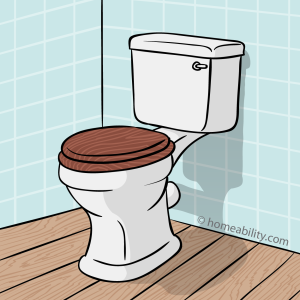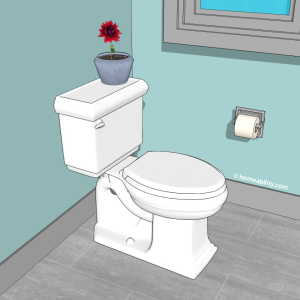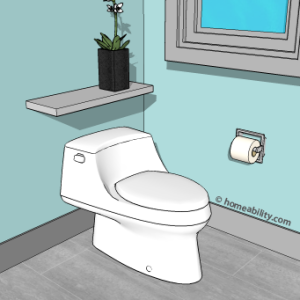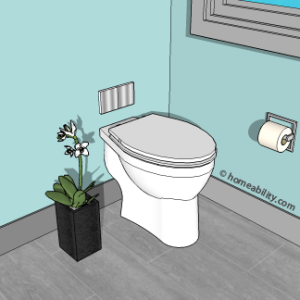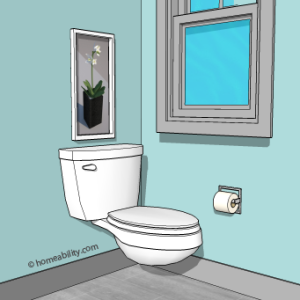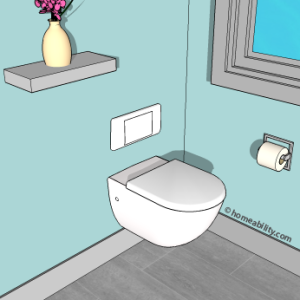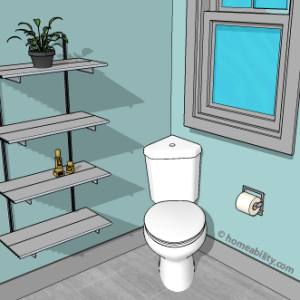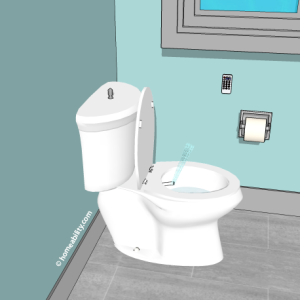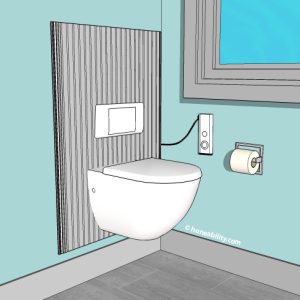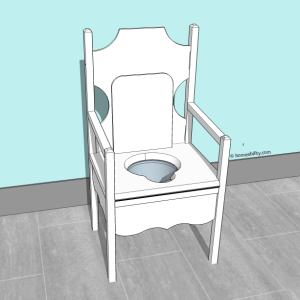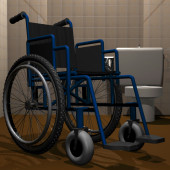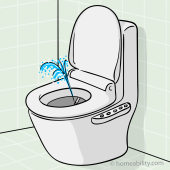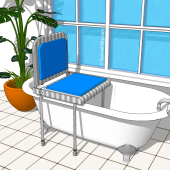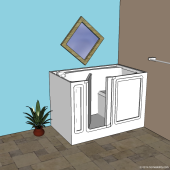Accessible Toilets & Toilet Equipment: The Basics
The reasons a person may have difficulty using the toilet can be many. Thankfully, inventors have come up with an abundance of great solutions to help with everything from
- getting on and off the toilet,
- to increased comfort while seated on the toilet,
- to assistance with hygiene after using the toilet.
If you are seeking a way to overcome one of these problems, there are two viable paths you can choose:
- Add equipment to your existing toilet, or
- Replace the existing toilet with a new toilet that comes equipped with the accessibility features you desire.
In order to determine which pathway is right for you, it’s helpful to first understand what your options are. We have provided a quick overview of the different options below to aid you in determining which is one best for your home and personal needs.
Equipment Options for Adapting Your Existing Toilet
A variety of different equipment can be added to, or around, your existing toilet to make it more accessible and easier to use.
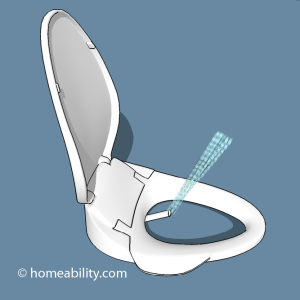 |
If you have sensitive skin or difficulty wiping, a specialized bidet-style toilet seat can be added to the existing toilet, making it possible for you to perform toilet hygiene without needing to physically wipe using toilet paper. Learn more. |
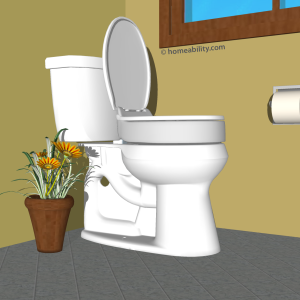 |
If you struggle to stand up from a low toilet, removing your existing toilet seat and replacing it with a taller toilet seat model is one option to make the transfer from sitting to standing easier. Alternatively, you can insert a spacer under your existing toilet seat to raise the toilet seat height. Learn more. |
 |
Another option for raising the height of the toilet seat is to purchase a toilet pedestal (aka toilet plinth) and have a plumber install it under the base of your existing toilet. This solution acts to raise the overall height of the toilet. Learn more. |
 |
Toilet rails provide a great place to hold on to when sitting down and a helpful place to push up from when standing up. They exist in a variety of forms, which include ones that are attached to specialized toilet seats, models with legs that extend down to the floor on either side of the toilet, or alternatively grab bars can be attached to the wall behind or along side the toilet. Learn more. |
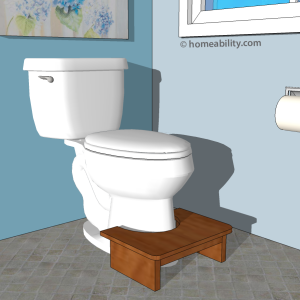 |
A step-stool can be a helpful addition for persons who experience difficulty moving their bowels, because it makes it possible to sit with knees positioned above the hips creating a traditional “squat-like position”, which is considered to be a more natural position for moving the bowels. Persons with short legs can also benefit from adding a step stool at the base of the toilet to prevent their legs from dangling when seated on the toilet. Learn more. |
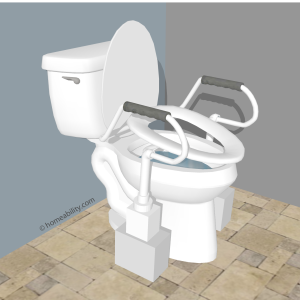 |
Specialized power-assisted toilet seats (aka “toilet seat elevators” and “power toilet seat lifts”) exist that can mechanically assist you with standing up from the toilet. With the push of a button, the seat assists to slowly raise you up, making the transition from sitting to standing easier. |
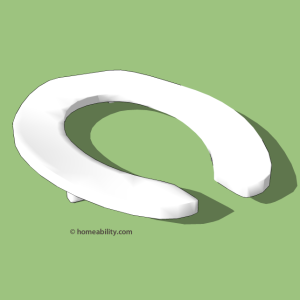 |
Some problems can be fixed by simply replacing the existing toilet seat with a new one. Toilet seats are available in narrow and wide seat widths, making it more comfortable for persons of differing sizes. Models can also be found with a cut out portion at the front or back of the seat making it easier to reach down to perform hygiene. Some models include padding to enhance comfort for those with sensitive skin. Learn more. |
Toilet Equipment Amazon.com
Which Type of Toilet is Most Easily Accessible?
Below you’ll find a quick overview of the different toilet types. Beside each we have identified some of the key elements that make each of them more or less easily accessible to aid you in determining which one will best match your own personal needs and architectural features of your bathroom.
- Two Piece Toilet (aka close coupled toilet)
- One Piece Toilet
- Comfort Height Toilet (aka Chair-Height Toilet, ADA Toilet)
- Makes it easier for taller individuals to sit down and stand up from the toilet.
- Makes it easier for some wheelchair users to slide from their wheelchair seat onto the toilet seat. Wheelchair users will have different wheelchair seat heights, so this needs to be addressed on a case-by-case basis whether a higher toilet seat height is appropriate or not.
- Back-to-Wall Toilet (aka BTW Toilet)
- Wall Hung Toilet Bowl and Tank
- Wall Hung Toilet Bowl
- Corner Toilet
- Toilet Bidet Combination
- Motorized Adjustable Height Toilet
- Portable Toilet (aka Commode, Portable Potty)
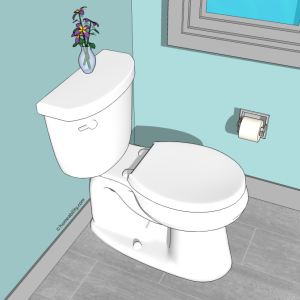 |
|
| Comfort Height Toilet | |
| What Is It? | A comfort-height toilet has a higher-than-average toilet seat height of 17-19 inches measured from the floor to the top of the seat, whereas, most toilets have a seat height of 16″ or less. |
| Pros: |
|
| Con: | Persons who are shorter in stature tend to find these toilets to be uncomfortably high. It can cause their feet to dangle down, which in turn can make the legs go numb while seated on the toilet. |
| Alert: | If you are seeking a toilet with a taller seat height, it is helpful to be aware that there is a difference between a toilet’s ‘bowl’ height and ‘seat’ height. The bowl height is the measurement taken from the floor to the top rim of the bowl and the seat height is the measurement taken from the floor to the top of the seat. Many manufactures only list the toilet’s bowl height because the toilet & toilet seat are normally purchased separately. When you only see the bowl height listed, you can assume that on average most standard toilet seats will add another 1″- 1.5″ when placed on top the bowl. To learn more about picking the best toilet seat height, click here. |
Comfort Height Toilets Amazon.com
Floor Standing Back to Wall Toilet Amazon.com
Wall Mounted Toilet Bowl With Tank Amazon.com
Wall Mounted Toilets Amazon.com
Corner Toilets Amazon.com
Bidet Toilet Combo Amazon.com
Elegant Commodes Amazon.com
What should you keep in mind when choosing a new toilet?
- Floor Space
If your bathroom is small and you use a walker or wheelchair, the smaller the toilet you select, the more space you will have to move and turn around inside the bathroom using your mobility device. - Toilet Bowl Size
A toilet with a compact-sized toilet bowl (round or square) is a good consideration if your bathroom is small. Most compact-sized toilet bowls occupy less floor space (often 2″ less) than models with elongated bowls. In a small bathroom, every inch counts! - Weight Capacity
Manufacturers typically do not list the maximum weight capacity when listing a toilet’s specifications. If installed correctly, most wall-mounted toilets will accomodate a minimum weight capacity of somewhere between 350 lbs up to 500 lbs. The specific amount will vary based on the model selected. A few wall-mounted models can accomodate up to 1,000 pounds. For the pedestal-style floor mounted toilets, the weight capacity varies by manufacturer. When we contacted American Standard and Kohler, the representatives we spoke to reported that as a general rule of thumb all of their floor mounted pedestal based toilets can accomodate 1000 pounds of static, vertical force. The representative we spoke to at Toto reported that as a general rule of thumb most of their pedestal-style floor mounted models can accomodate somewhere between 400 lbs to 500 lbs. If there are persons living in your household who have bariatric needs, we recommend to confirm with the manufacture what the maximum weight limit is for the model selected prior to purchasing. - Toilet Height
When selecting an accessible toilet, many people immediately think “the higher the seat height the better”. This is not always true. The taller toilets, known as Comfort-Height Toilets, can be uncomfortably high for shorter adults, children, and some wheelchair users. Ideally, select a toilet model with a seat height that is high enough that you can easily transition on and off the toilet, yet low enough that you can comfortably rest your feet flat on the floor when you are seated on the toilet. To learn more about how to choose the best toilet height, click here. - Location & Type of Flush Controls
The toilet flusher comes permanently fixed to a specific part of the toilet, so it is important to take this feature into consideration prior to selecting a toilet model. Toilet flushers come in four different types and can be found in a variety of locations, which include: a lever-style handle located on the right or left front-side of the toilet tank; a button that is located on the top center of the toilet tank or on the wall behind the toilet, a pedal located at the base of the toilet that can be operated using a foot, or an automatic touch-less flusher that is operated via sensors. - Installation
Floor-mounted toilets are easiest to install. Any licensed plumber should be able to install a floor-mounted toilet correctly. If you have a wall-mounted toilet installed, it is important to select a professional who is experienced with installing this type of toilet to ensure the support structure is installed inside the wall correctly. - Ease of Cleaning
If you have difficulty bending and reaching low surfaces or hate the task of cleaning behind and around a standard floor-mounted toilet, a wall-mounted toilet is a good consideration. The lack of pedestal base makes it much easier to pass a mop underneath the bowl to clean the floor around the toilet. - Water Efficient
Selecting a Watersense-labelled toilet (a toilet that meets certifications for using less water per flush) and/or a dual-flush toilet (one that allows you to select the amount of water used based on whether the toilet contents are solid or liquid) can help you to conserve water and save on monthly water bills.
Average Cost to Install Floor & Wall Mounted Toilets
Standard, floor-mounted toilets will usually cost on average $200-$500 to purchase and have installed. A wall-hung toilet can cost on average $1,500-$2,000 to purchase and have installed. Wall-hung toilets cost more, because there are more parts to purchase and it takes more time to install the support frame inside the wall and/or to reinforce the existing walls.
If you are anxious to conserve space inside the bathroom, but finances won’t permit you to purchase a wall-hung toilet, then a “floor-mounted” toilet with the tank concealed inside the wall is a good consideration. It is less expensive to install than the wall-mounted toilets because it does not require the same support structure, but can still help to conserve space since the tank is neatly hidden away inside the wall.
Prices will be lower than those shown here if you can install it yourself and may vary from those listed here, depending on the brand selected and your geographic region.
Toilets Amazon.com
The Homeability Advice™ 
If you are designing a bathroom, with the intent being that it should be user-friendly for everyone who enters (immediate family, grandparents, friends who visit), one of the most important features to include is ample clear floor space. If space is at a premium inside the bathroom, the wall-hung style toilets with a concealed water tank are a great consideration. Since the tank resides inside the wall, an extra 9″-12″ or more of clear floor space becomes available in the bathroom, making it easier to move and turn around with a walker or wheelchair. The lack of pedestal base also makes it much easier to clean the bathroom floor around the toilet. (Yeah!)
If both space and finances are limited, a good compromise is to install a “floor mounted back-to-wall” toilet. The water tank is tucked away inside the wall, so you gain extra floor space, but it does not cost as much to install because the pedestal base supports the weight of the toilet (and you), hence less structural changes need to be made to the wall.
Bidet-toilets (and bidet-toilet seats) are a great consideration for everyone! It does the washing – no wiping required. A toilet that’s enhanced with bidet features can be a particularly helpful addition for persons suffering from incontinence because it makes it much easier to stay fresh and clean. It can also be a great relief for persons with hemorrhoids. Some models (ones with a more powerful water stream) can be helpful for persons who suffer from constipation as well. If you are on a tight budget, replacing your existing toilet seat with a “bidet-style toilet seat” is a much more budget-friendly option than installing a new toilet with bidet features integrated into the design.
Once you have determined the general type of toilet you feel will work best for you, then it will be necessary to narrow it down further to which manufacturer, make and model you like within the given categories. In future articles we will be exploring each of these categories in more detail, including the specific models and manufacturers. To stay up to date as new articles are added, sign up for the Homeability Newsletter.
More Topics You May Be Interested In
- “I can’t wipe myself!”: 6 Solutions to Make Toilet Hygiene Easier
- “I Can’t Get Up From the Toilet!” 10 Remedies
- Bidets: An Overview of the Basics
- Best Type of Toilet for a Wheelchair User
- Falls – Equipment to Help You Get Up Again

